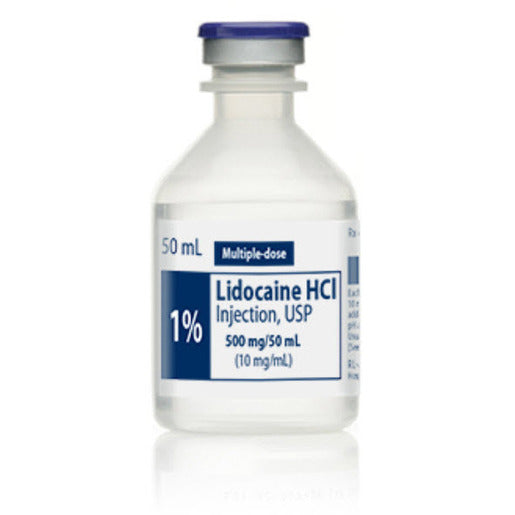Lidocaine Hydrochloride 1% for Injection 50 mL Multiple Use Vial, 25/Pack by Pfizer (Rx)
(Note: We don’t Fill Personal Prescriptions)
How to Order:
You will receive instructions on how to create an account along with Rx Ordering Details.
Lidocaine Hydrochloride 1% for Injection is a local anesthetic agent used to provide temporary relief of pain associated with various conditions. It is a white, crystalline powder that is freely soluble in water and slightly soluble in alcohol. Lidocaine Hydrochloride 1% for Injection is administered by injection and produces a transient local anesthesia. It is used to provide anesthesia for dental procedures and to relieve pain from various conditions, such as shingles, cancer, and labor.
Pfizer Injectables Lidocaine Hydrochloride 1% Injection 50mL Vial is local anesthetic and is used during surgeries, pregnancies, and general dental work. Each lidocaine Hydrochloride 1% vial slowly reduces the of pain signals to the brain and eventually numbs the area you’re targeting.
- Sterile
- 500mg / 50mL vial (10mg / mL)
- 25 per tray
- NDC 0409-4276-02
Details and Features
Concentration: 1% (10 mg/mL) Lidocaine Hydrochloride
Volume: 50 mL per vial
Formulation: Sterile solution for injection
Packaging: Multiple-use vials, typically available in 25 per pack
Preservative-Free: Often preservative-free, which is ideal for patients with hypersensitivity to preservatives
Manufacturer: Pfizer
Application: Administered to produce local or regional anesthesia by injection
Mechanism of Action
Lidocaine functions as a local anesthetic by binding to and inhibiting voltage-gated sodium channels on the nerve cell membrane. This blockage prevents the initiation and conduction of nerve impulses, resulting in a temporary loss of sensation in the targeted area.
Warnings
-
Allergic Reactions: Risk of allergic reactions in individuals with known hypersensitivity to lidocaine or amide-type local anesthetics.
-
Cardiovascular Risks: Use with caution in patients with a history of cardiac conditions as lidocaine can affect cardiac function.
-
Central Nervous System Effects: Caution in patients with central nervous system conditions as lidocaine can cross the blood-brain barrier.
- Precaution in Pregnancy and Nursing: Evaluate the risk versus benefit for use during pregnancy or lactation.
Side Effects
Common Side Effects:
- Mild swelling or redness at the injection site
- Temporary numbness or tingling sensation
Serious Side Effects:
-
Cardiovascular: Bradycardia, arrhythmias, or hypotension
-
CNS Effects: Dizziness, nervousness, confusion, or seizures
-
Allergic Reactions: Urticaria, rash, or anaphylaxis
- Systemic Toxicity: Symptoms like tinnitus, blurred vision, or tremors indicating high systemic levels
Administration and Monitoring
Lidocaine Hydrochloride 1% for Injection should only be administered by qualified healthcare providers experienced in the management of local anesthetic techniques and the detection and management of potential side effects. Monitoring vital signs and readiness to address any immediate allergic or systemic reactions is crucial. Always consult detailed prescribing information for specific guidelines and contraindications.

